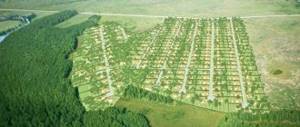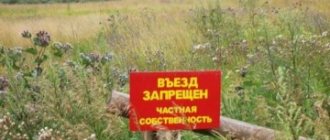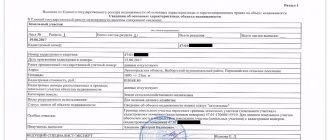Having made a survey, disputes arise about the boundaries, since often the results do not coincide with the data of the cadastral passport (it turned out to be smaller or larger). What to do if, during land surveying, the area has increased/decreased? In the article we will consider this issue, and also find out whether it is possible to change the boundaries after land surveying, how to legally increase/decrease, and correctly register the increase/decrease of the site. Then we will study how land ownership increases through “cuts”? The actual area and boundaries of land plots do not always correspond to the data specified in the cadastral passport of the property. It happens that a land user has conscientiously owned extra acres for several decades. However, the mere fact of bona fide ownership of a land plot is not enough to formalize your rights. What happens in such situations when the land plot is actually larger than according to the documents? Read on.
The procedure for increasing land ownership by registering “additions”
After land surveying, the site became larger. How should I design it? Another special case when the boundaries of an allotment can increase after land surveying is the design of “additions” that are actually already in use or that the owner just wants to add to his land.
The right to increase their territory in this way for owners of dachas, private houses, garden plots, vegetable gardens and subsidiary plots is provided for in clause 3, part 1, art. ZK RF.
This is possible if such a territory is bordered by state or municipal lands that are not classified as public lands and have not been withdrawn from circulation.
The procedure for making a cut is as follows:
- the landowner applies to the authorized body with an application for the redistribution of plots in private and public ownership;
- the authority sends him consent to such redistribution if there are no grounds for refusal (the land has not been withdrawn from circulation, not provided to another person, etc. - a total of 13 grounds for refusal);
- the applicant hires a cadastral engineer to record the resulting lands and registers them in the Unified State Register of Real Estate;
- a redistribution agreement is signed, which specifies the fee for which the lands are transferred from public to private ownership.
Applications for redistribution of land plots.
ATTENTION! The plot obtained as a result of registration of an “addition” should not be larger than the established maximum size for landholdings of this type.
You will learn how to cut land to a site from the video:
How to increase the area
The transfer of the boundaries of land plots can be carried out as a result of their redistribution and clarification.
Redistribution of boundaries is a mutual change in the boundaries of adjacent plots of land, which can be either private or municipal property.
An increase in the area of a land plot by moving its boundaries is regulated by the following articles of the law:
- Art. 11.9 of the Land Code of the Russian Federation determines the requirements for land plots, the area of which changes as a result of boundary work to redistribute or clarify boundaries;
- In Art. The Land Code of the Russian Federation provides reasons for increasing the area of the site and existing restrictions;
- Art. The RF Land Code describes the procedure for concluding an agreement with local authorities on moving borders with an increase in area.
Increasing the area of a site by moving boundaries can be achieved by:
- Public lands that are in municipal ownership;
- Lands of neighboring plots.
It is important to consider that the area of the plot cannot be increased by more than one tenth of the original without a court decision.
To increase the area at the expense of municipal public lands, the owner of the plot must enter into an agreement with the land committee of the local municipality.
The conclusion of an agreement to increase the area occurs in the following steps:
- The owner of the plot applies to the land committee with an application and the necessary documents;
- Committee staff consider the application within 30 days;
- Based on the results of the consideration, the applicant is issued either permission to coordinate boundaries or a written refusal indicating the reason;
- After receiving permission, the applicant organizes cadastral work at his own expense;
- Based on the results of the work carried out, the boundary plan is submitted again to the land committee for final approval;
- Corresponding changes are made to the legal register.
In the application, the owner of the land plot must indicate all its parameters. As well as your own details and contact information for communication.
If some of the data is incorrect or incomplete, the application must be returned within 10 days from the date of submission, indicating all inaccuracies and recommendations for correcting them.
The following documents should be attached to the application, in accordance with clause 3 of Art. ZK RF:
- Copies of documents on the right to the plot and the origin of this right;
- Plan diagram of the location of the boundaries of the site relative to neighboring lands;
- For foreign organizations - translation into Russian of the certificate of state registration of a legal entity.
Documents on the right to the plot are not required if information about the owner of this plot is entered into the Unified State Register of Real Estate, then only an extract from the real estate register about the owner will be required.
The translation of the certificate of registration of a foreign legal entity must be certified by a notary, and a site plan is provided only in the absence of an approved boundary plan for the territory to which the applicant’s land plot belongs.
Failures due to excess area
These are cadastral works that are carried out by a specialist - a cadastral engineer, and data on which are included in the Unified State Register of Real Estate. IMPORTANT! For the owner, the land survey means that restrictions on disposal are lifted from his land. That is, he can start building a house and make any transactions with land:
- sell;
- present;
- pass on by inheritance.
What to do after land surveying? Upon completion of the preparation of the boundary plan, you need to register the result of clarifying the location of land ownership boundaries in Rosreestr - submit documents for making changes to the Unified State Register of Real Estate. This can be done by the owner or the cadastral engineer himself. Reasons for changing boundaries Completion of cadastral work means that the boundaries of the site have been clarified and it has been finally determined as an object of civil law.
Documenting
When changing the boundaries of a site, in addition to the standard steps for registration, that is, drawing up a survey act and a boundary plan, registration in the Cadastral Chamber and registration with Rosreestr, you also need to contact the local administration. It will be mandatory to obtain permission to change the boundaries of the site in the area controlled by the municipality - without this, further steps to formalize it will not be possible.
We suggest you read: How to allocate a plot of land for an apartment building
Reasons for changing boundaries
Completion of cadastral work means that the boundaries of the site have been clarified and it has been finally determined as an object of civil law.
How to increase the area of land after land surveying? It is impossible to arbitrarily change the boundaries after completion of the procedure - this requires a strong legal basis: an agreement, a court decision or recognition of a cadastral error.
Often, after the completion of land surveying, landowners are faced with the question: is it possible to change the boundaries of the land plot after surveying, and annex neighboring empty lands to their plot in order to smooth out the unevenness of its borders, expand the area in front of the house, or equip a parking space?
The legal grounds for increasing the site after land surveying can be:
- registration of “addition” through the redistribution of land provided for in Art. Land Code;
- correction of an error made by a cadastral engineer;
- acquisition of a neighboring plot of land as a property (as a result of donation, purchase, inheritance) and merging it with the existing one.
How to change the boundaries of a land plot after land surveying?
A reduction in land ownership is possible if the court recognizes the rights of a neighbor to a part of the plot that was determined to be controversial in the act of reconciling boundaries. It can also occur due to the recognition of a mistake and as a result of the division of the plot for the subsequent alienation of part.
Justification for reducing the area of the land plot
When clarifying the location of the boundaries of land plots located within the boundaries of the territory of a horticultural, gardening or dacha non-profit association of citizens, the location of the boundaries of these land plots is determined in accordance with the territory surveying project approved in the manner established by the legislation on urban planning or the project for organizing and developing the territory of such an association of citizens or another document establishing the distribution of land plots in such an association of citizens. 3. When clarifying the location of the boundaries of the land plot defined in paragraph 1 of part 1 of Article 42.1 of this Federal Law, its area determined taking into account the requirements established in accordance with the Federal Law of July 13, 2020 N 218-FZ “On State Registration of Real Estate”, should not be: (ed.
Land surveying procedure
Land surveying is a geodetic procedure during which the boundaries of a site and its area are clarified using special equipment and methods.
Only state-licensed specialists can do it. Based on the results of their measurements and calculations, they draw up a boundary plan - a detailed document containing the parameters of the site, and explanations in text and graphic form.
The boundaries of the land plot are agreed upon with the neighbors. This does not always work out, but their approval is desirable, and notification of land surveying is mandatory; without the invitation of neighbors, the procedure simply will not be valid.
Finally, the result of all efforts is the entry of new information about the site into Rosreestr and the assignment of land rights to the citizen. He will own not an approximate plot, which, according to the provisions coming into force in 2021, cannot even be sold, but a territory with precisely defined boundaries, and will be able to dispose of it without restrictions.
When surveying the land plot, the area increased
An increase in land allotment due to the elimination of an error occurs if the cadastral engineer, when preparing the boundary plan, incorrectly indicated the boundaries of the land.
There are two ways to detect an error:
- by looking at your plot on the public cadastral map;
- having ordered the removal of boundaries in kind from a geodetic company.
If during land surveying the area turns out to be larger and an error is discovered, then a new land survey is required - preparation of a land survey plan to correct the cadastral error. If the situation is favorable, the case will be resolved pre-trial by agreeing on a new location with the neighbors.
If you cannot reach an agreement peacefully, you will have to go to court. Based on the court decision, the cadastral engineer prepares a new boundary plan.
How to challenge the boundaries of a land plot after surveying, watch the video:
How to resolve a case without trial?
There are several such methods, and it all depends on the specific situation. For example, we buy out excess territory. To do this, it is enough to find out whether the site has an owner and who he is. You can try to negotiate a buyout with a private owner. It was not possible to reach an agreement, which means that everything will be decided in court, which is what happens in most cases.
If a specific owner of the territory has not been found, then this can only mean one thing – the municipality owns the land. This will be the best solution for us, since it is not beneficial for the authorities to have the land empty. And if it is possible to resolve such a question, then usually the answer is positive.
The owner of the updated site must write an application to the administration requesting recognition of the new boundaries of your site. The following documents must be attached to it:
- Identity card (passport).
- An act stating that this site has been allocated specifically to you.
- Land survey plan with new boundaries.
If the decision is positive, your plot will become larger without a trial. In the negative, you will be held accountable for land squatting.
Reducing the area of land.
Info If there are no documents, the boundaries of the land plot are recognized as boundaries that have been in effect on the area for more than fifteen years and are fixed by natural or artificially created objects. Clarification of the location of the boundaries of a plot registered in the cadastral register is carried out in certain cases:
- at the time of acquisition of ownership of a previously registered plot of land;
- in disputes with neighboring owners;
- before selling the plot;
- in case of errors in cadastral documentation;
- before dividing the site into several plots;
- for documenting cuttings.
Boundary clarification is carried out by a cadastral specialist from the federal register of cadastral officials, or by a geodetic company that holds a license to conduct land surveying.
What does it mean to clarify the boundaries of a land plot?
According to the Real Estate Department of the Ministry of Economic Development of Russia, set out in letter No. OG-D23-4587 dated June 16, 2014, restrictions associated with reducing the area of a land plot in connection with clarifying the location of its boundaries are not established by current legislation.
In this regard, the section of the boundary plan “Conclusion of the cadastral engineer” should reflect the justification for the results of the relevant cadastral work with the attachment (if any) to the boundary plan of documents confirming the location of the boundaries of the land plot.
There are several ways to carry out the procedure to clarify the location of the boundaries of a land plot while simultaneously increasing its area. The basic norm that specialists adhere to when carrying out work requires the coincidence of land use categories for the combined territories. It is equally important that the annexed areas are not in use by other persons or organizations.
The owner of the land can apply for the expansion of a land plot for vegetable gardening, subsidiary or dacha farming, gardening and individual residential construction. Carrying out geodetic work - geodetic survey of real estate and land boundaries - 1 week. 5. Office processing of field work materials - preparation of a boundary plan - 1 week.
How to justify reducing the area of a land plot
Articles by our lawyers Question of the day on the topic: Lists of houses for demolition 2016: Home Lawyer online Land law Reducing the area when surveying a land plot Nikolay, Noginsk City, Moscow region, at 01:09 During registration, 4 acres were cut. On what basis or law did they do this? A little background.
My grandfather had a plot of 30 acres. During the measurement, everything went well, as it should all 30. A surveyor from their land surveyor. When submitting documents and further operations during registration, it turns out that 4 acres go to the left.
There are no explanations. Please help. Thank you in advance. Is it possible to cancel the registration and do it again, with the return of my 30 acres, which were also given to my grandfather for farming? Answered by: lawyer, Egorov Konstantin Mikhailovich, Moscow Book a consultation by phone. — 8 (495) 740-55-17 Hello. There can be many explanations for this circumstance. Consequences of the absence of an established border If the extract from the Unified State Register contains a record that the border of a plot of land has not been established in accordance with the requirements of land legislation, you should think about it. This applies to the potential owner and the upcoming land purchase transaction. Important The buyer must understand that the absence of established boundaries of the site does not guarantee compliance with the rights of the owner regarding the passage of the boundaries of the site. This often leads to disputes that escalate into litigation. If the buyer purchases a plot of land without established boundaries, he will have to establish them at his own expense. The legislation establishes that from January 1, 2020, when concluding any administrative transactions, the presence of fixed boundaries will be mandatory. It will be impossible to sell, donate, rent out or inherit a plot of land without a land surveying procedure.
What difficulties may arise?
When transferring extra acres to yourself, you should not forget about two nuances that may interfere with the procedure for registering extra acres.
So, firstly, it is possible to increase the area of land owned free of charge only if one condition is met - the land plot being registered must not exceed the minimum minimum amount of land when allocated.
As Part 5 of Article 27 of Federal Law No. 221 indicates, “the additional part should not exceed the maximum minimum plot size established ... for lands of the corresponding intended purpose.”
An example of the interpretation of this norm!
For example, in many regions of the country, plots for summer cottage construction are allocated with a size of 6 acres. This standard area is also minimal. Consequently, based on the letter of the law, the owner of the land in dacha construction does not have the right to add more than 6 acres to his property.
Or for individual housing construction, the allocated minimum is 2-3 acres, depending on the location of the land. This means that the owners of land allocated for individual housing construction cannot add more than 2-3 acres, which are actually in their possession.
The determination of the indicated minimum land plots during allocation is within the competence of regional legislators and local governments. A direct reference to this norm is contained in Article 33 of the Land Code of the Russian Federation. However, not all regions establish minimum land allocations. In such cases, the Law “On the State Real Estate Cadastre” indicates that the permissible maximum of land added free of charge will be equal to 10% of the land area indicated in the cadastral passport.
Secondly, the cadastral engineer, when drawing up a boundary plan, must provide a justification for increasing the area. This is indicated in the Law “On the State Real Estate Cadastre”.
Article 38 Federal Law 221:
“When clarifying the boundaries of a plot, their location is determined based on the information contained in the document confirming the right to the land plot, or in the absence of such a document, from the information contained in the documents that determined the location of the boundaries of the land plot when it was formed. If the specified... documents are missing, the boundaries of the land plot are the boundaries that have existed on the ground for fifteen years or more and are fixed using natural objects or objects of artificial origin that make it possible to determine the location of the boundaries of the land plot.”
What to do if the area is larger?
In order to update the cadastre data and legitimize the increase in the size of land holdings, it is necessary to ensure that there are grounds and possibilities for this.
It is possible to assign “extra” meters to the owner already at the stage of cadastral registration if:
- the minimum size of a land plot in the region where it is located has not been established;
- the increase in the size of the plot does not exceed 10% of the area of land ownership indicated in the ownership documents;
- the area of the enlarged plot does not exceed the maximum size of land plot established in the region.
In these cases, when preparing the boundary plan, the cadastral engineer will indicate the current boundaries and the corresponding area. Upon registration, updated data will be entered into the cadastre, which will be reflected in the cadastral passport. With a new cadastral passport, you should contact Rosreestr to obtain the appropriate certificate of ownership.
If the area of the plot is larger than the maximum permitted, the owner has the right to:
- refuse to increase the size of property;
- buy additional square meters into ownership.
Clarification and change of location of boundaries and area of the site
Attention Statement of Claim and Attached Documents Before applying to the district court to clarify the boundaries of a plot of land, the applicant must familiarize himself with the legally correct form of the statement of claim. When filling out, you must adhere to the following rules:
- Heading of the statement of claim - indicates the judicial body to which the petition is sent, contacts of the plaintiff or his representative, and the defendant. When paying the state fee, its amount is indicated.
- The title of the document, “Statement of Claim to Establish the Boundaries of a Land Plot,” is located in the middle and there is no period at the end of the sentence.
- Contents - information about the land plot owned by the plaintiff, its exact address, numbering according to the cadastre, information about the carrying out of boundary work are indicated.
Controversial issues regarding changes in land area
Despite the owner’s desire to bring the documents for the land plot into proper condition, the cadastral chamber may make a decision to suspend registration or refuse registration.
There are many reasons for making such decisions. Let's consider each situation separately.
The reasons for suspension of registration are most often errors or inconsistencies in information.
For example, the owner has submitted the entire package of documents, but the information provided in them does not correspond to the information in the cadastre. Registration will be suspended in order to determine what information is correct. The reason may also be the overlap of plot boundaries or their intersection.
Another reason is the submission of an incomplete package of documents.
If the owner refuses to cooperate, then the consequence of such actions may be a refusal to register the land plot.
We suggest you read: Divorce in the presence of a child under 3 years old
Refusal to register is also not uncommon.
As with suspension, the reason for refusal will be the failure to provide a complete package of documents and the presence of errors in them. An application from an unauthorized person is another reason for refusal. If the plot is formed from lands of various economic purposes, or the border of a populated area passes through it, then registration will also be refused.
The reasons for the refusal can be seen in the decision to refuse registration; their indication is mandatory.
In order to solve this problem, you can eliminate the indicated reasons and re-apply, or you can seek justice in the courts.
No matter how good relations with neighbors are, the division of land often leads to disputes and conflicts. The best way is to resolve the conflict that arose during land surveying and coordination of borders through peace. You need to try to pull up old documents that will show how the areas were allocated. The best evidence is documentary facts.
If all the arguments have been exhausted, and a common language and ways to solve the problem have not been found, all that remains is to go to court.
Land disputes are a costly matter, a matter that requires a large number of documents, and even the most insignificant nuance that the owner did not pay attention to can play a decisive role in making a court decision.
Self-occupation of land
Independent seizure of empty land is not uncommon. It is legal to obtain permission to use a land plot, and besides, paying taxes for it is much more difficult and expensive than simply using it for your own purposes without filling out any documents.
But the “owners” of such lands need to keep in mind that administrative liability is provided for such actions.
If a citizen unauthorizedly uses land whose purpose is for general economic purposes, the fine will range from 500 to 1000 rubles. If it is a forest or water area, the amount of the fine will increase many times over.
In order to avoid such measures of state coercion and reaction, you can contact the local administration with an application to allocate a plot of land for free use. This practice has been provided for by law since March 1, 2020.
After five years of using such land, this plot can be transferred into ownership.
In order to understand the position of the authorities on this issue, let us turn to judicial practice.
The position of the courts when considering this category of cases remains unchanged: a change in the area of an allotment of land during its surveying should be associated with clarification of its boundaries, and not entail a spontaneous increase in area due to self-seizure.
Thus, the decision of the Novokubansky District Court refused to satisfy the demands of the plaintiff - an individual - to the administration of the Novokubansky District to establish the boundaries of the land plot. The court found that, on the basis of a certificate of land ownership, the plaintiff owns a land plot with an area of 520 m², which is registered in the cadastral register, and its boundaries are conditional.
After geodetic work, a boundary plan of the land plot was prepared; according to this document, the area of the plaintiff’s plot was 1187 m². The boundary plan indicates that the site borders on municipal lands, the approval of which was refused by the district administration, since the area of the demarcated site is significantly larger than the area indicated in the certificate of ownership.
The court refused to satisfy the plaintiff's demands, correctly pointing out that the plaintiff did not provide evidence of legal ownership of a land plot with an area of 1,187 m², and the district administration received objections regarding the boundaries of the site. In this regard, it is not possible to establish the boundaries of the disputed area on the basis of the presented boundary plan.
The court found that the essence of the plaintiff’s statement was not the clarification of the boundaries of the land plot, which he set out in the statement of claim, but the appeal in his favor to the squatting of the municipality’s land.
What lands are not subject to privatization?
When re-registering “additional acres” in your name, you should take into account the legal nature of these lands. Is it possible to obtain private ownership of this plot of land? This is the question every land user should ask when registering their rights to the “extra acres.” The Land Code contains a rule limiting the turnover of a certain category of land.
Thus, the following plots are not subject to transfer of ownership:
- within specially protected natural areas;
- from the forest fund lands;
- within which water bodies that are in state or municipal ownership are located;
- provided for the needs of transport and communications organizations;
- located within the boundaries of lands reserved for state or municipal needs;
- located in the first and second zones of sanitary protection zones of water bodies used for drinking and domestic water supply.
The Water Code of the Russian Federation also contains a rule banning privatization. Thus, it is prohibited to privatize lands within the coastal strip where there are flooded quarries and ponds.
There are often cases when lands from the forest fund are adjacent to dacha plots. Taking advantage of the situation, citizens are taking over forest lands. Despite this, the Forest Code prohibits the registration of ownership of such lands. In this case, the length of time the land is in the use of the summer resident does not matter. It should be borne in mind that Article 71 of the Forest Code of the Russian Federation allows for the provision of land from the forest fund for free use for a certain period and for lease .
How much land can you add?
In practice, there are often cases when the data on the area and boundaries of a land plot in title documents are not identical to the actual state of affairs. There are many reasons for this. Most often, the discrepancy between the data in the cadastral passport and the actual boundaries of the land was the result of improper measurement of the land. Experts say that land surveying previously took place without reliable tools, which results in a significant error in the area of land on paper and in fact .
In addition, there are often cases when owners of dacha plots willfully change the boundaries of their lands, moving fences and partitions on their plots. So, a situation arises when a person owns 6 acres according to documents, but the actual area of the property is 7-8 acres. How can the owner act in such a situation? How to obtain documents for additional plots of land?
Only if data on the boundaries of the land is not entered into the state real estate cadastre, then the land user has the right to register ownership of the “extra” acres free of charge.
The reason for the lack of accurate data about the land is most often the lack of land surveying procedures.
Only on the basis of land surveying can all data on the location and area of a land plot be legally obtained. Several categories of owners of summer cottages can re-register “extra” acres. First of all, these are landowners or their heirs who received real estate during the Soviet Union. Also, certain problems and difficulties in law enforcement practice existed before the adoption of the Land Code of the Russian Federation. It turns out that persons who acquired land before October 30, 2001, before the entry into force of a single codified act in the field of land legislation, will most likely re-register additional parts of the land without any problems.
What is the mechanism for “adding land”? A cadastral engineer or surveyor draws up a boundary plan. The area and location of the boundaries of the land plot are established and documented. At his place of residence, the owner with a land survey must contact the cadastral chamber. When filling out an application to change the cadastral passport of an object, it would not hurt to indicate the legal basis, referring to the Law “On the State Real Estate Cadastre”, namely Article 45 part 7.








